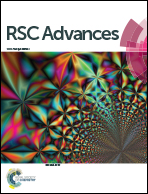Synthesis and characterization of magnetic copper–iron-titanate and uptake studies of americium from nuclear waste solutions†
Abstract
Magnetic materials, which find enormous applications due to their benign nature, can have their efficiency and stability enhanced by incorporation of foreign materials and controlling the synthesis conditions. Herein carbon containing iron-titanate (TF) and copper–iron-titanate (CTF) magnetic materials were prepared by a solvo-thermal method in methanol at 200 °C/20 h. Physico-chemical analysis techniques, such as BET, PXRD, FE-SEM, HR-TEM, zeta potential, XPS and NH3-TPD, were used to investigate the materials' structure and textural properties. Further, the prepared materials were used as a sorbent for the uptake of 241Am radiotracer from low pH solutions. The adsorption studies showed excellent uptake efficiency for radioactive 241Am by copper–iron-titanate (CTF), and it followed the Langmuir isotherm and pseudo-second order sorption kinetics. In addition, 1/n calculated from the Freundlich isotherm (∼0.33) indicated the favourable sorption of 152,154Eu (surrogate of 241Am) sorption by both CTF and TF. The NH3-TPD studies revealed a change in the electronic properties of the metal centre and supports the chemisorption based sorption behaviour of the CTF magnetic material. Desorption of the loaded metal ion was facile with 0.1 M HNO3 and the CTF nanomaterial can be effectively reused.


 Please wait while we load your content...
Please wait while we load your content...